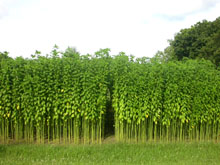History of Jute

Jute Plant
For centuries,jute has been an integral part of culture of Bengal, in the entire southwest of Bangladesh and some portions of West Bengal. During the British Raj in the 19th and early 20th centuries, much of the raw jute fiber of Bengal was carried off to the United Kingdom, where it was then processed in mills concentrated in Dundee. Initially, due to its texture, it could only be processed by hand until it was discovered in that city that by treating it with whale oil, it could be treated by machine The industry boomed (“jute weaver” was a recognized trade occupation in the 1901 UK census), but this trade had largely ceased by about 1970 due to the appearance of synthetic fibers. Margaret Donnelly, a jute mill landowner in Dundee in the 1800s, set up the first jute mills in Bengal. In the 1950s and 1960s, when nylon and polythene were rarely used, one of the primary sources of foreign exchange earnings for the erstwhile United Pakistan was the export of jute products, based on jute grown in then East Bengal now Bangladesh. Jute has been called the “Golden Fiber of Bangladesh.” However, as the use of polythene and other synthetic materials as a substitute for jute increasingly captured the market, the jute industry in general experienced a decline. During some years in the 1980s, farmers in Bangladesh burnt their jute crops when an adequate price could not be obtained. Many jute exporters diversified away from jute to other commodities. Jute-related organizations and government bodies were also forced to close, change or downsize. The long decline in demand forced the largest jute mill in the world (Adamjee Jute Mills) to close in Bangladesh. Bangladesh’s second largest mill, Latif Bawany Jute Mills, formerly owned by businessman, Yahya Bawany, was nationalized by the government.
Farmers in Bangladesh have not completely ceased growing jute, however,mainly due to demand in the internal market. Between 2004– 2010, the jute market recovered and the price of raw jute increased more than 500%. Jute has entered many diverse sectors of industry, where natural fibers are gradually becoming better substitutes. Among these industries are paper, celluloid products (films), non-woven textiles, composites, (pseudo-wood), and geo textiles. In 2006, the General Assembly of the United Nations proclaimed 2009 to be the International Year of Natural Fibers, so as to raise the profile of jute and other natural fibers.
Jute and jute-based products are put to a wide range of uses. Since antiquity it has been used as a raw material for packaging. Before being used as a commercial commodity it was used in different parts of the world to make household and farm implements such as ropes, hand made clothes, wall hangings, etc. In Bengal sacks and saris made of jute were commonly used in the Middle Age. Export of sacks started in the 18th century. Its leaves and roots were used as herbal medicine, and as vegetable by the local people. Its use as an industrial commodity began in the Crimean war when it was used as a substitute of flax. Its use was popularized primarily in Western Europe, particularly at Dundee. Traditionally, use of jute products are limited to packaging materials like twine, hessian, gunny bag, twill, carpet backing, wool pack, tarpaulin, mats, canvas, wall cover, upholstery, and as furnishing fabrics of different types and natures.
Importance of Jute Sector to the Economy of Bangladesh: Bangladesh once enjoyed the monopoly in production and marketing of jute & jute goods in the world market. At present Bangladesh is the second largest producer of jute, India being the largest one. But Bangladesh produces the finest quality of jute due to favorable climate and soil condition. About 12 lac (1.2 million) acres of land is in use for jute cultivation per year in the country.
Bangladesh on an average produces 50-55 lac (5.0-5.5 million) bales of raw jute which is 30% of world production per year. Out of these 20-25 lac(2.0-2.5 million) bales are exported and 30 lac (3.0 million) bales are consumed by the jute mills, leaving the rest for domestic consumption and carryover. About 5.5-6.0 lac MT jute goods are produced in the country annually out of which 70-75% is exported. Bangladesh meets nearly 95% of world raw jute demand and about 60% of jute goods demand. Bangladesh approximately earns foreign currency worth about 2000 crore taka from exporting raw jute and jute goods on an average per year. Still today Bangladesh is the largest supplier of jute and jute goods in the international markets. At present there are more than 150 composite & twine Jute Mills in Bangladesh in public & private sector. They are producing traditional products along with various types of twine & diversified jute products. About 35 million people (25% of the total population) of Bangladesh is directly or indirectly dependent on Jute cultivation and manufacturing, trading of Jute & Jute goods. Jute industry is the 2nd largest industrial employer in the country and about 10% of the total labor force is engaged in jute sector.
Thanks for the good article, I hope you continue to work as well.